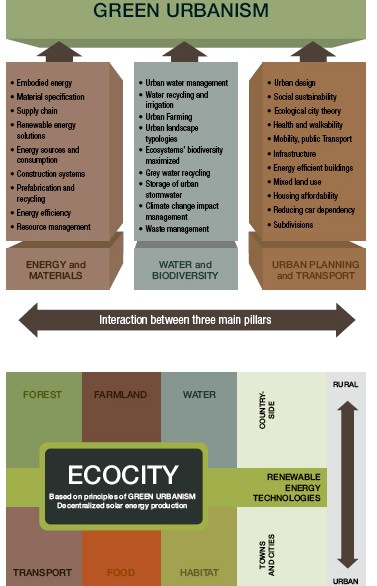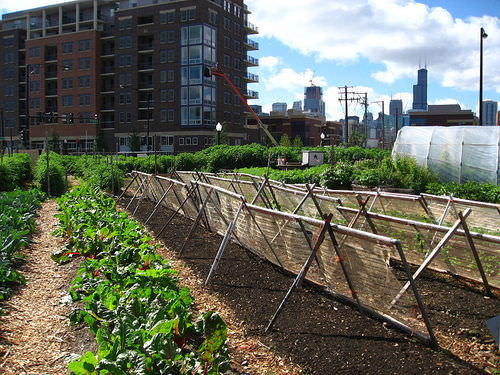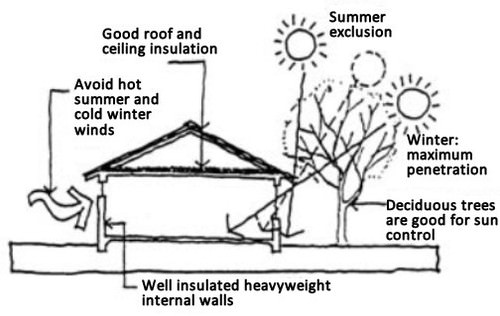14.4: The Sustainable City
- Page ID
- 11808
Sustainability finds expression in the way we shape our cities. Cities are not just a collection of structures, but rather groups of people living different lifestyles together. When we ask if a lifestyle is sustainable, we’re asking if it can endure. Some archaeologists posit that environmental imbalance doomed many failed ancient civilizations. What could the sustainable city look like, how would it function, and how can we avoid an imbalance that will lead to the collapse of our material civilization?
Our notion of sustainability is modeled on ecosystems because they have persisted through time without the need for outside intervention as long as they have not been damaged or destroyed by humans. Ecosystems even recover from severe natural disasters through the process of succession. There are two guiding principles that govern how the natural world functions. These are the laws of conservation of matter (that matter cannot be created nor destroyed) and the laws of thermodynamics (that energy cannot be created or destroyed, but flows through systems and dissipates into the environment as it is transferred).
Throughout history settlement patterns have been set by technology and commerce. Civilizations have produced food, clothing and shelter, and accessed foreign markets to purchase and sell goods. Workers traditionally had to live near their place of occupation, although in modern industrial times advanced transportation systems have enabled us to live quite a distance from where we work.
In hindsight we can see how reliance on water and horse-drawn transportation shaped historical civilizations and how this equation was radically altered with the rise of the automobile following World War II. While attempting to envision the “Sustainable City” we must discern what factors will influence its shape and form in the future.
Green Urbanism and Sustainable Cities
New urbanism (sometimes referred to as green urbanism) is a conceptual model that seeks to transform and re-engineer existing city districts and regenerate the post-industrial city centre. It promotes the development of socially and environmentally sustainable cities. The following principles of green urbanism offer practical steps on the path to sustainable cities, harmonizing growth and usage of resources.
 Figure \(\PageIndex{1}\): Green Urbanism.
Figure \(\PageIndex{1}\): Green Urbanism.Climate and Context
Every site or place has its own unique individual conditions in regard to orientation, solar radiation, rain, humidity, prevailing wind direction, topography, shading, lighting, noise, air pollution and so on. The various aspects of this principle include:
- Climatic conditions, which can be incorporated into the design of any project
- understanding the site and its context
- optimizing orientation and compactness to help reduce heat gain or losses
- achieving a city with minimized environmental footprint by working with the existing landscape, topography and resources particular to the site, and the existing micro-climate of the immediate surroundings.
- Maintaining complexity in the system (biodiversity)
Sustainable design focuses on the unique attributes of a given location and seeks to take advantage of the natural environment in a way that can reduce energy consumption and minimize waste. This means there are no one size fits all solutions, so the initial cost of designing sustainably can be higher than the alternatives, but that initial investment typically pays off over the long term.
Renewable Energy for Zero CO2 Emissions
A goal of sustainability is to be carbon neutral. The various aspects of this principle include:
- Energy efficiency
- promoting increased use of renewable power
- the transformation from being an energy consumer to an energy producer
The local availability of a renewable source of energy (such as solar or wind) is the first selection criteria for deciding on energy generation. In general, a well-balanced combination of energy sources can sensibly secure future supply.
Zero-Waste
Sustainable waste management means turning waste into a resource. Sustainable cities focus on adopting the zero-waste management system seen in ecosystems, where all resources are recycled and there is no buildup of waste products over time. Zero-waste urban planning includes reducing, recycling, reusing and composting waste to produce energy. All material flows need to be examined and fully understood, and special attention needs to be given to industrial waste and e-waste treatment. Waste prevention is always better than the treatment or cleaning-up after waste is formed.
Water
Sustainable water use should align with the focus on the law of conservation of matter, which governs the cycling of water as a resource. As much as possible, regional development should conform to local water availability and this should guide water conservation efforts as well as efficient and wise use.
Landscape, Gardens and Urban Biodiversity
Sustainable cities should have a strong focus on local biodiversity, habitat, ecology, and the protection of regional characteristics. They should optimize green spaces and access to public parks, gardens, with opportunities for leisure and recreation. In addition, these should be made available equitably to all socioeconomic groups living within the region. A city that preserves and maximizes its open spaces, natural landscapes and recreational opportunities is a more healthy and resilient city. Sustainable designs of developed areas should take into account the native biodiversity and ecosystem services provided by the natural landscape. This can be augmented by a strong focus on inner-city gardens, urban agriculture and green roofs, with the added benefit of promoting a resilient local food supply.
 Figure \(\PageIndex{3}\): Urban Farming in Chicago. Some new crops being started, protected by shade cloth barriers to the west.
Figure \(\PageIndex{3}\): Urban Farming in Chicago. Some new crops being started, protected by shade cloth barriers to the west.Urban areas with a substantial amount of pavement and other artificial services tend to experience higher temperatures than more natural landscapes. This is known as the urban heat island (UHI) effect, and it leads to increased energy consumption as well as expenses for businesses and residents. The UHI effect can be mitigated by capitalizing on the use of trees and landscaping for air-purification and urban cooling. Further, the narrowing of roads, which calms traffic and lowers the UHI effect, allows for more (all-important) tree planting. Preserving green space, gardens, and farmland, maintaining a green belt around the city, and planting trees can also absorb carbon dioxide and be an effective means of addressing climate change.
Green Buildings and Districts, Using Passive Solar Design Principles.
The concept of green building encompasses low-energy, zero-emission designs. Perhaps the best-known certification program for green buildings comes from Leadership in Energy and Environmental Design (LEED), which provides a rating system for the design, construction, and operation of sustainable buildings. However, LEED Certification is only one approach and there are many ways to incorporate sustainable principles into building design. Ultimately, it is often said that sustainability is a design issue. Although the up-front costs associated with sustainable design may be higher, it is often more challenging to redesign or retrofit existing inefficient buildings to take advantage of the principles of sustainability.
Many green buildings incorporate passive solar design principles (Figure below), which can dramatically reduce building energy use. This approach takes advantage of the orientation and exposure of the building relative to the sun in order to minimize energy use throughout the year, primarily through heating and cooling. This can include maximizing ventilation patterns for cooling, relying upon natural light, optimizing solar gain (heating) in the winter and shading in the summer. The ideal is to create buildings that generate more energy than they consume and collect and purify their own water.
 Figure \(\PageIndex{6}\): Passive Solar Design
Figure \(\PageIndex{6}\): Passive Solar Design
Local Food and Short Supply Chains
At the community level, sustainable cities tend to have a focus on local food production and an emphasis on urban farming and agriculture, including `eat local’ and `slow food’ initiatives. This can dramatically reduce costs and pollution associated with transporting food. Sustainable cities achieve this by incorporating adequate land for food production via urban agriculture and community gardens as well as by establishing green belts which protect the open space and agricultural lands surrounding the community. Ultimately, these approaches serve to bridge the urban-rural disconnect and move cities towards models that deal in natural eco-systems and healthy food systems.
Cultural Heritages, Identity and Sense of Place
Sustainable cities typically aim to reduce pollution, foster resilient communities, and to have strong public space networks and modern community facilities. However, each city has its own distinct environment, whether it be coastal, desert, mountain, or any other landscape option, and each of these provides different resources as well as challenges. Whether the climate is tropical, arid, temperate, or otherwise, each situation is unique. The design of the city will take all these factors into consideration, including materials, history and population desires.

